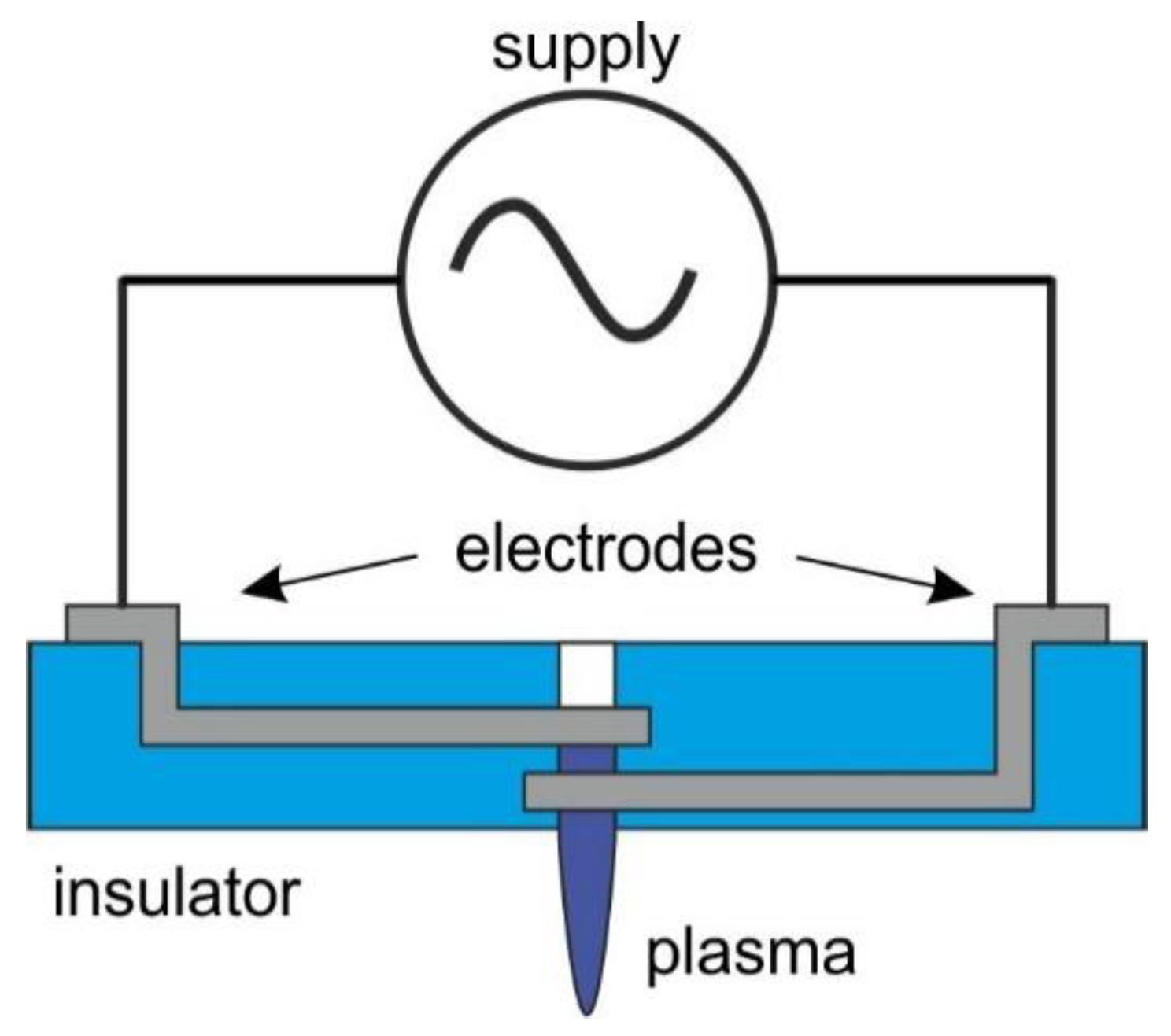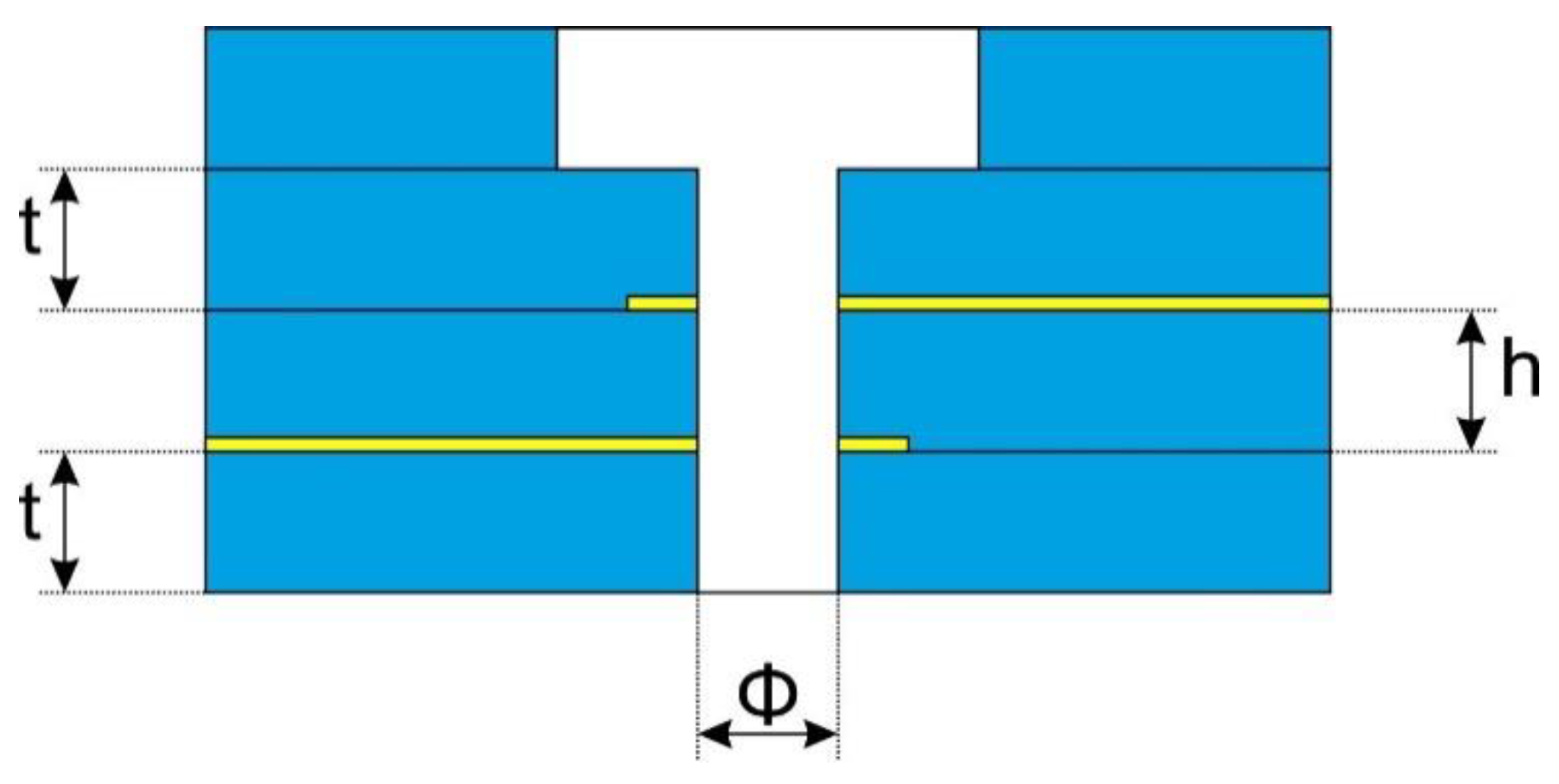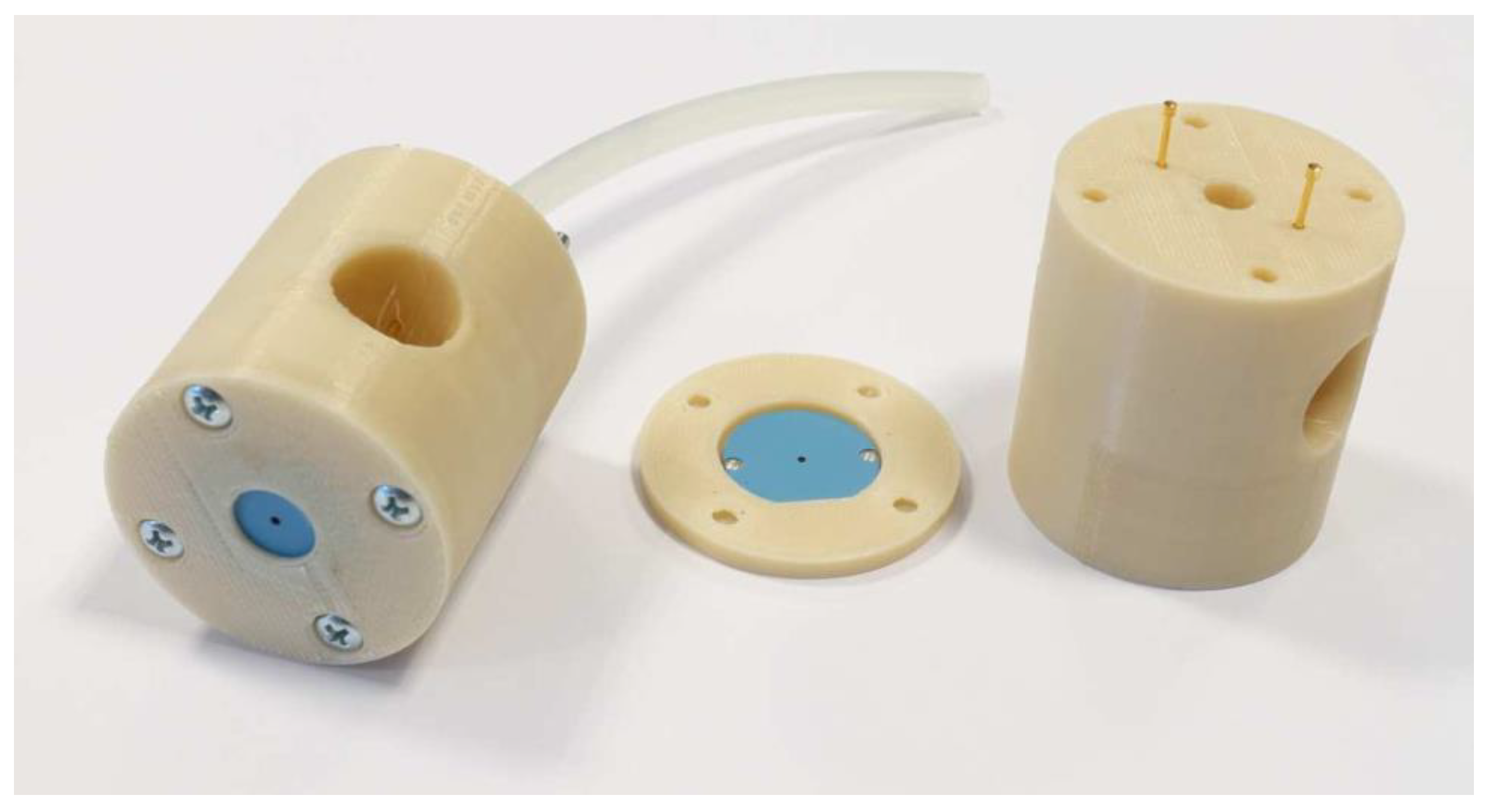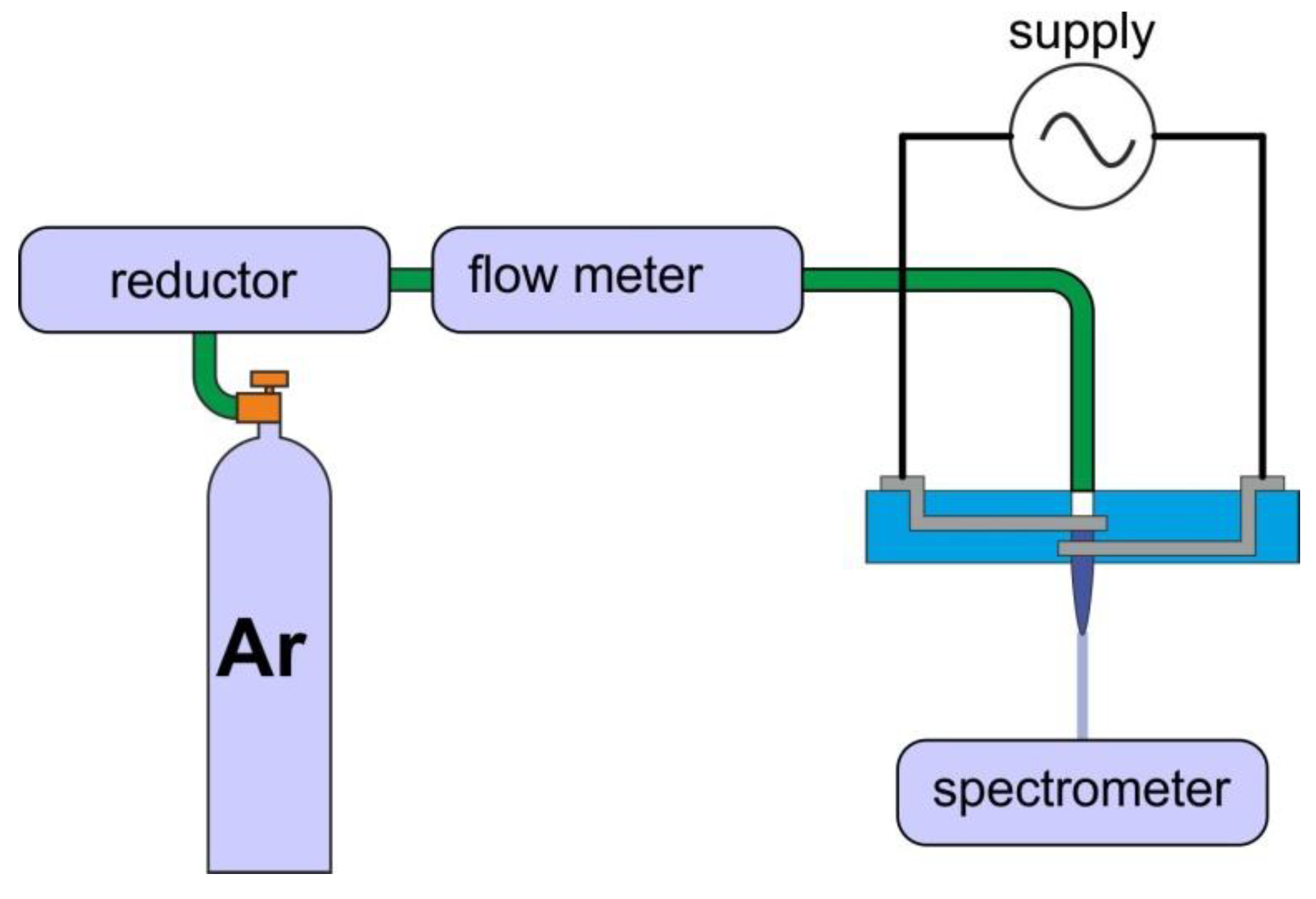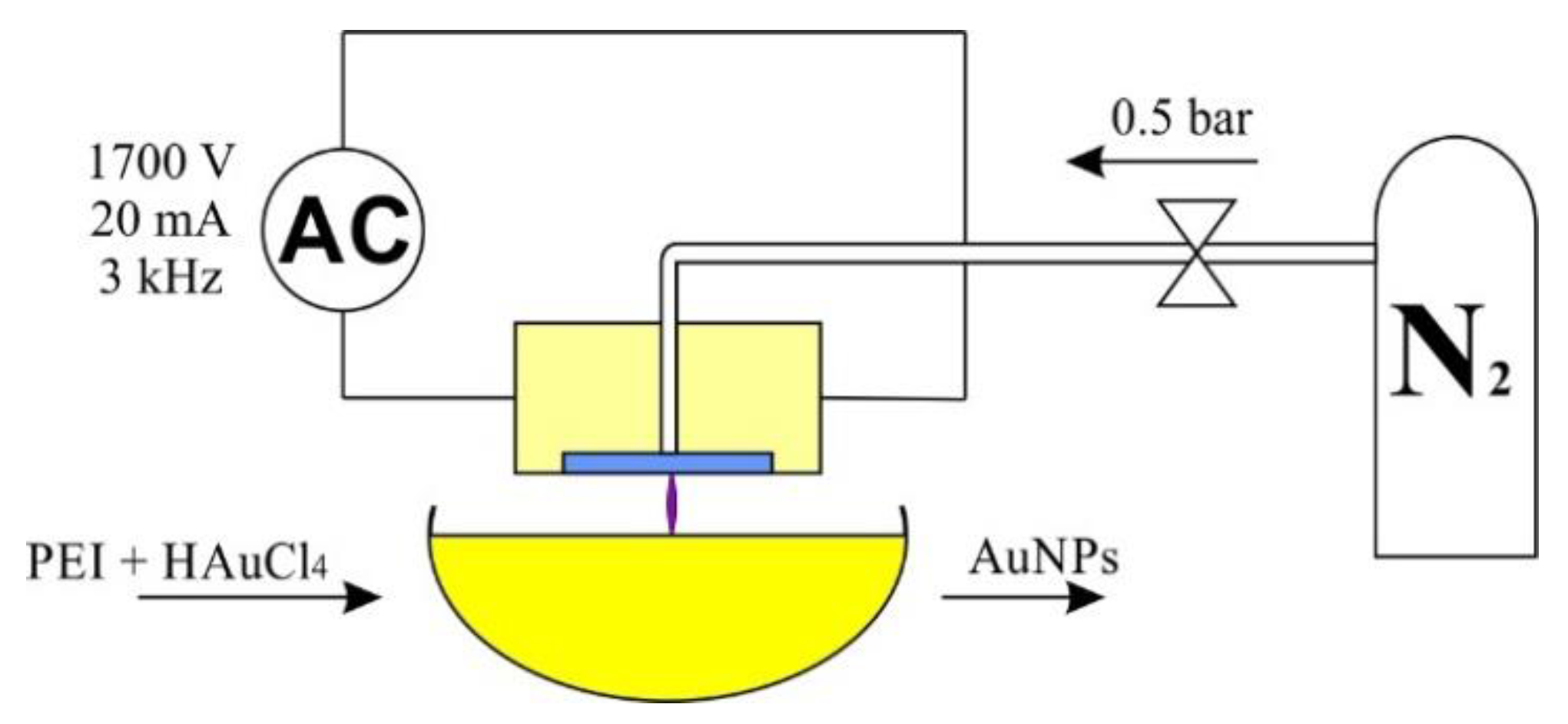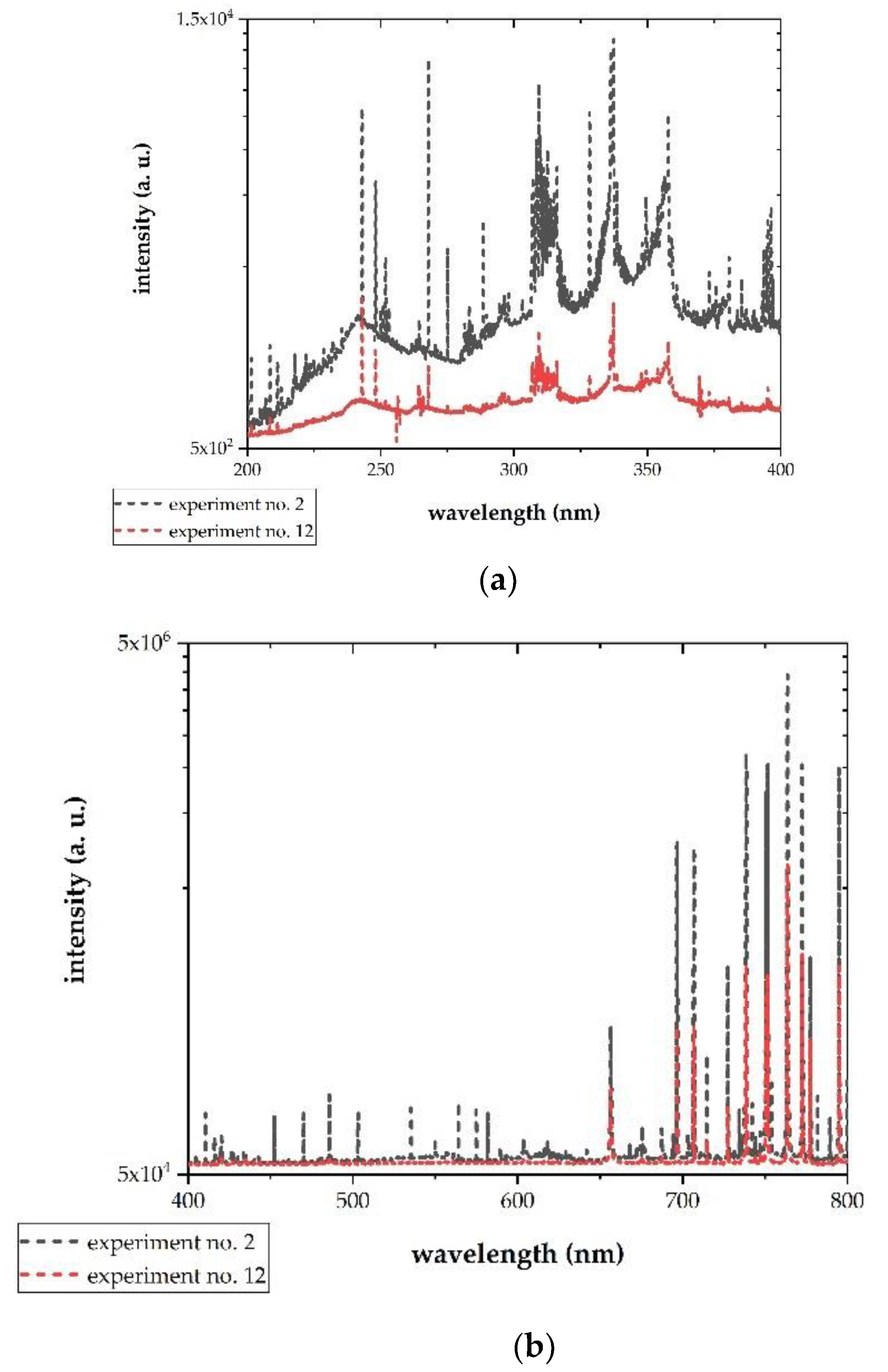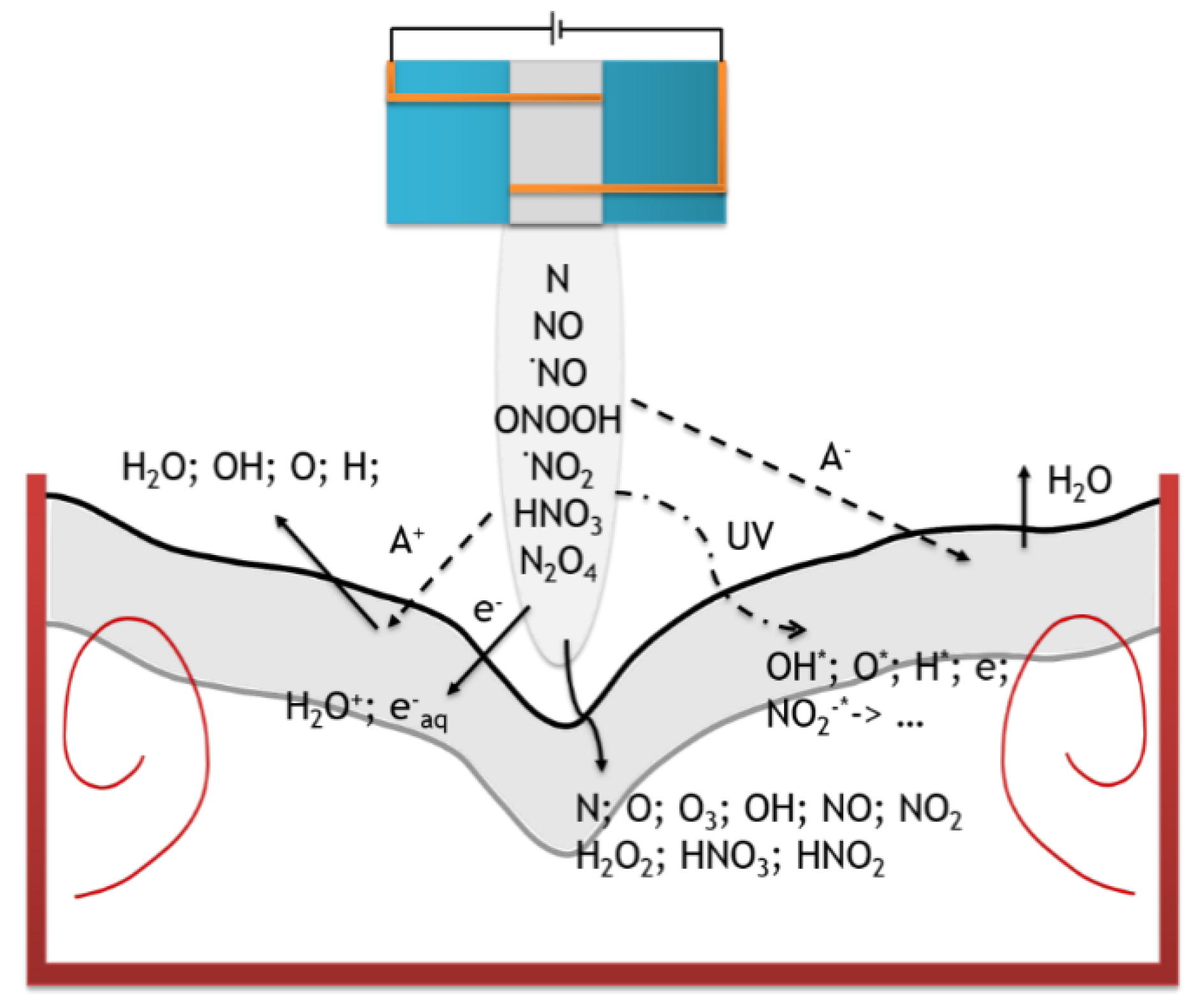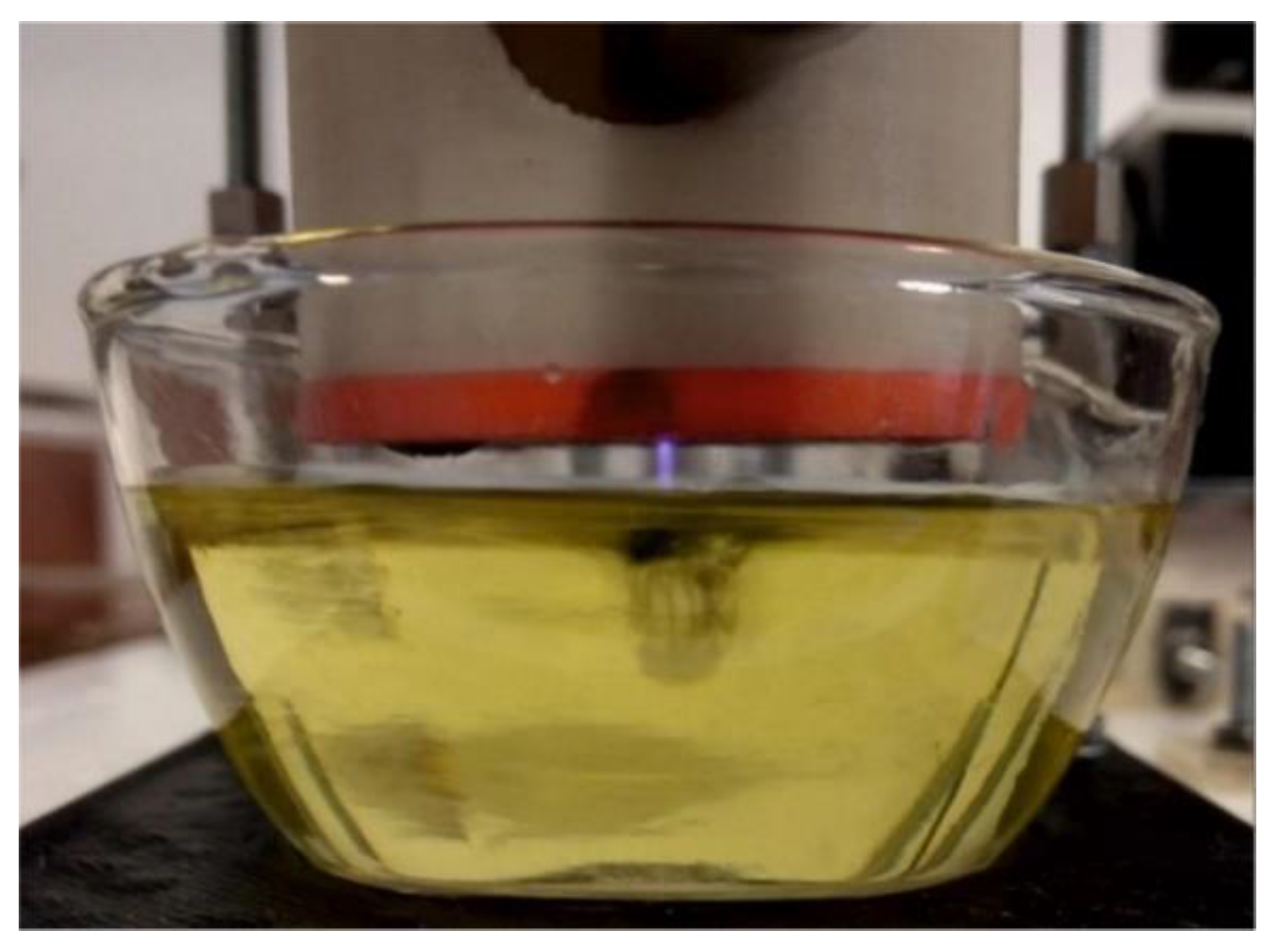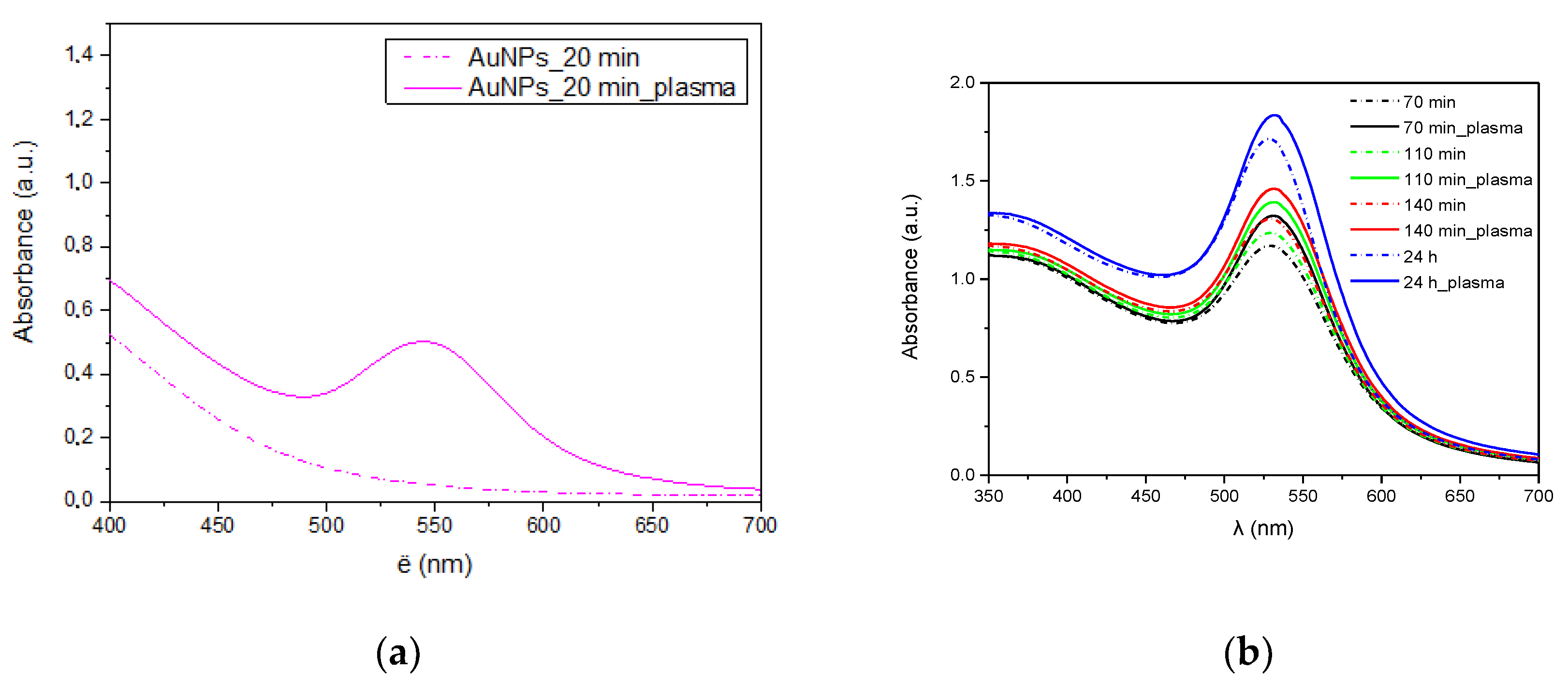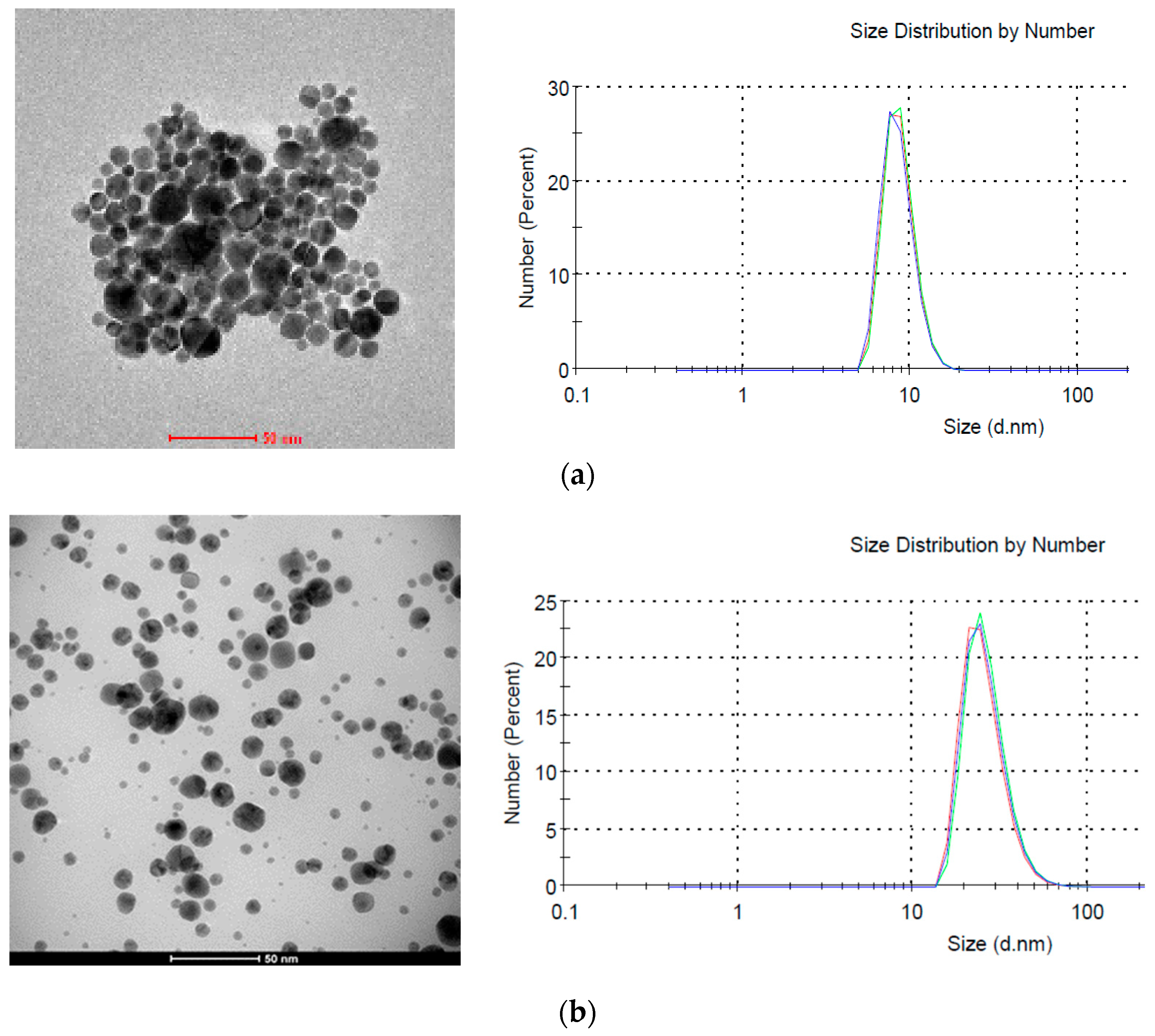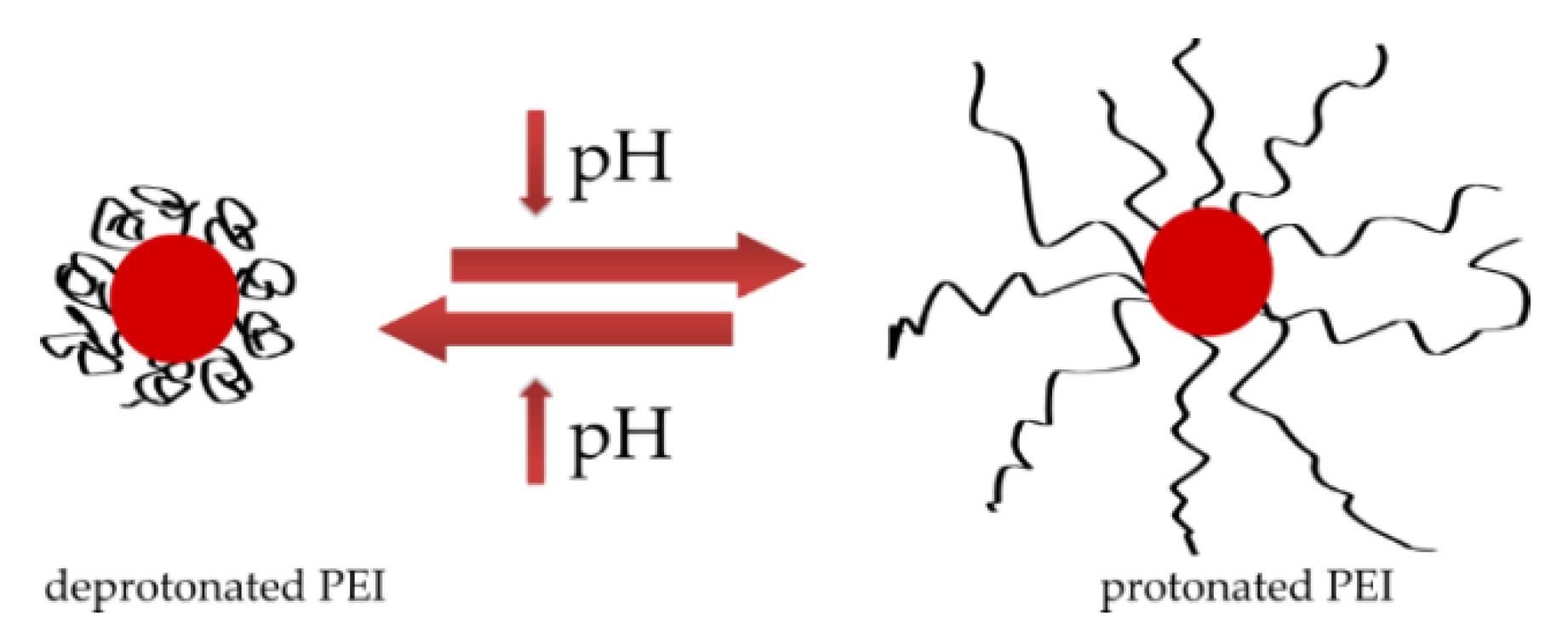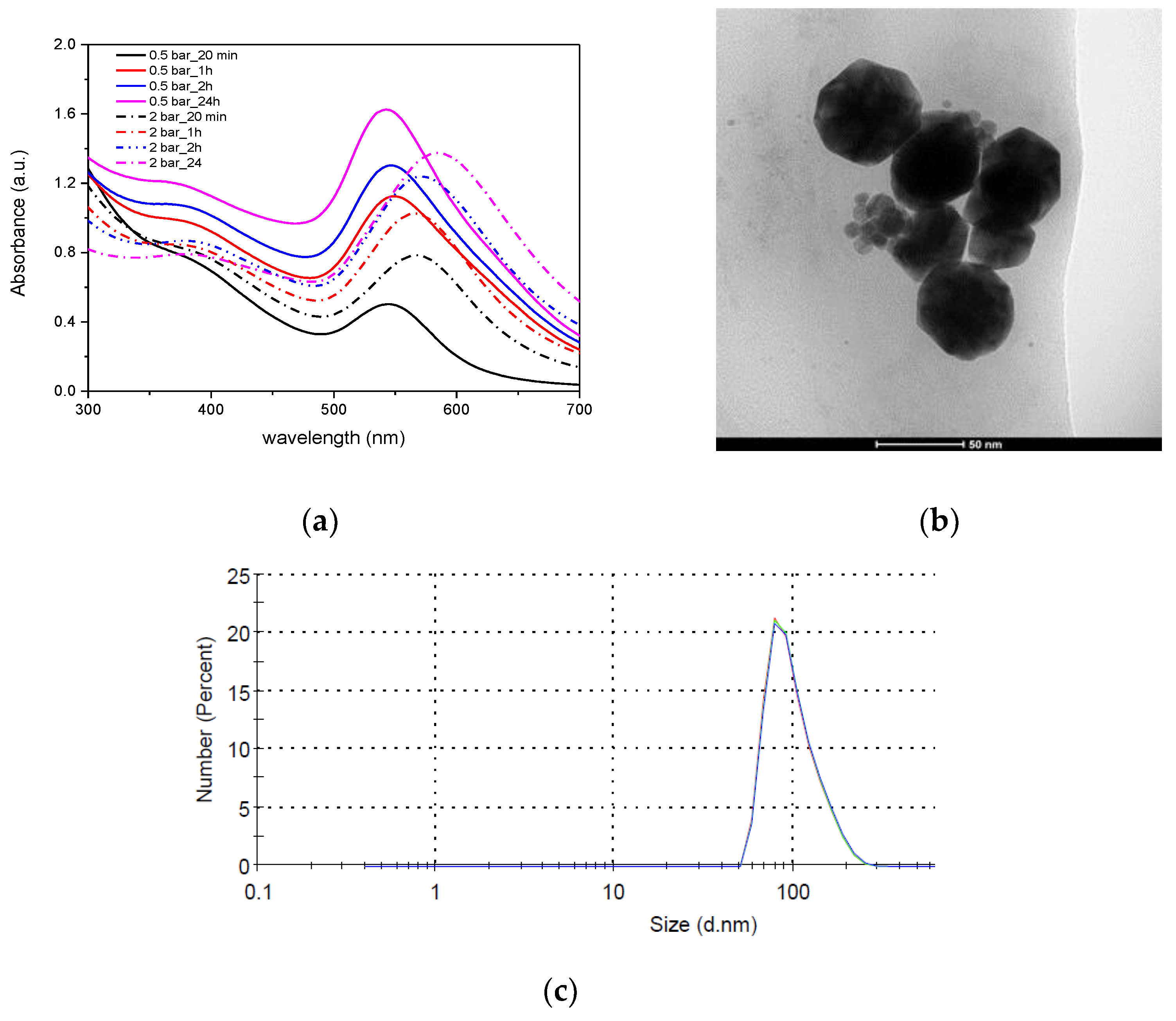1. Introduction
Plasma is one of the four fundamental states of matter which is an ionized gas exhibiting collective behavior. It can be generated by delivering sufficient amount of energy in a specific form, e.g., in electrical DC and AC discharges. Cold plasma jets are the most interesting among other plasma devices. They have numerous advantages such as generation of plasma under atmospheric pressure, simple construction and a variety of properties of the generated plasma [
1]. They can be used for the treatment of solids or liquids surfaces, their modification, biologic sterilization or chemical synthesis [
2]. Typical plasma jets are made by means of fine mechanics. They have some drawbacks, such as high power consumption and generation of thermal (hot) plasmas. Hot plasmas reach temperatures of more than 10,000 K, which is required in spraying of high melting point metals and alloys, but it excludes them from other applications.
In the recent 20 years, plasmas with dimensions smaller than one millimeter, have been generated in atmospheric pressures. This reduces the cost of a plasma device and makes it available for more applications. The type of an application determines the construction of jets and, as a result, properties of the generated plasma. There are many types of APPJs based on the arrangement of electrodes and frequency of discharge voltage. Obviously, not all of the materials remain unaffected by the plasma treatment, but ceramics and glass do.
Ceramic materials are resistant to chemical compounds, high voltages and high temperatures during the plasma jet operation [
3]. The low temperature cofired ceramics (LTCC) technology combines these advantages with the possibility of 3D structures fabrication and easy deposition of conductive paths. It is one of the microelectronic technologies which were developed for manufacturing microfluidics systems [
4]. The ability of LTCC to fabricate multilayer circuits opens this technology to microsystem technology (MST), which is applied in the production of various sensors [
5]. The LTCC has already been used for fabrication of plasma generators [
5,
6,
7,
8] for s elements in liquidous solutions [
6,
7,
8,
9] or flowing gas [
10].
In the literature there are numerous examples of the synthesis of plasma-assisted gold nanoparticles (AuNPs). These methods most often differ with the type of plasma generator used or the stage of synthesis at which the plasma was applied. Chloroauric acid is commonly used as a precursor of gold ions. Most often, the reduction of gold ions occurs at the plasma–liquid interface or directly in the liquid when one of the electrodes is immersed in the reaction solution. As a result of a plasma treatment, various nitrogen compounds are formed. They have good solubility in water, which significantly lowers the pH of the plasma activated water (PAW). In case of oxygen plasma, the
ions reduction is conducted in the presence of reactive
,
,
,
,
,
and
radicals [
11]. However, the mechanism of the influence of plasma on the formation of gold nanoparticles is not well understood and in many publications one can find various proposals for the reaction of the formation of gold nanoparticles. According to some sources, various types of reactive nitrogen and oxygen or high-energy electrons can act as gold-ion reducers. All of these particles or their mixtures reduce gold ions and replace traditional, often toxic, reducing agents [
11]. The mechanism of obtaining gold nanoparticles in oxygen plasma has been described many times, however, there are few reports on the preparation of gold nanoparticles in nitrogen plasma. This publication will propose possible reactions of reducing gold ions in a cold nitrogen plasma environment.
A synthesis as a result of plasma action in water, ethanol or liquid nitrogen makes it possible to obtain AuNPs with a dimension of the order of several nm [
12,
13]. In an aqueous solution at ambient temperature using glow discharge plasma allows the formation of gold nanoparticles as a result of plasma plating of an aqueous solution of chloroauric acid without the addition of stabilizers or reducing agents. The particle size obtained in such conditions increases with the concentration of gold ions [
14]. High-energy electrons can also play an important role in stabilizing nanoparticles. Liang et al. [
15] postulate that, as a result of plasma plating, gold nanoparticles with a negative surface charge, which can repel each other preventing agglomeration, are formed. Wang et al. [
16] obtained gold nanoparticles in water with the atmospheric-pressure nonthermal microplasma method. Sodium citrate was used as a reducer. They determined that the AuNPs size distribution is affected by the mixing mode, stabilizer concentration and plasma power. Plasma-assisted synthesis can also be carried out in non-aqueous solutions such as dodecane containing sodium bis (2-ethylhexyl) sulfosuccinate as a stabilizer [
17].
Nanoparticles can be synthesized in flow reactors [
18,
19] or by plasma plating of a constant volume of solution, as in this publication. The use of plasma as a gold ion reducing agent in aqueous solutions without the use of additional reducing agents (such as sodium borohydride) has increasing medical applications. The nanoparticles formed with this method can be used in imaging, drug transport and cancer therapy [
12]. In addition, most methods that use plasma do not require the use of expensive and advanced equipment, and the gold nanoparticles obtained in cold atmospheric plasma have a synergistic anticancer effect [
12].
The main purpose of the article was to present the mechanism of gold nanoparticles synthesis in the presence of plasma. In the first stage using an atmospheric pressure plasma jets (APPJs) plasma activated water (PAW) was obtained and accurately characterized in terms of chemical properties. This knowledge allowed describing the mechanism of gold nanoparticles formation under the influence of plasma on the system.
4. Discussion
As it can be seen in
Table 7, the optical temperatures have changed significantly in individual experiments. The lowest measured T
rot was 506 K, the highest 739 K with a median of 633 K and the mean value close to it 623 K. For T
exc, the lowest recorded value is 4186 K, the median is 4986 K, average value 6472 K, and the highest value is 18,509 K. However, it should be noted that the latter value is subject to a very high measurement uncertainty. This is due to the fact that for such a high temperature, the T
exc model loses its accuracy. Nevertheless, in some experiments this temperature exceeded 10,000 K, despite these limitations.
The use of the L27 table allows the estimation of the influence of individual factors on the measured values. This is done by averaging the measured values for those measurements where the factor took a certain level (low, medium or high). For example, for parameter t, average values are calculated from experiments 1–9 for low level, 10–18 for medium level and 19–27 for high level (see
Table 4). The calculated values are summarized in
Table 6. The phenomena occurring in the microplasma are complex and related to each other. However, the obtained results allow making some interpretations.
With increasing thickness of the dielectric barrier t, discharge current and electric field density decrease. As a result, the power delivered to the plasma is limited and so is Trot. On the other hand, Texc increases, because with a lower electron density and shorter mean free path, collisions between electrons and other particles are less frequent. Therefore, energy transfer from electrons decreases, which elevates Texc. For the rest of geometric parameters, namely height h and diameter Φ relations are not so simple. Basically, smaller dimensions increase power density and Trot. Interestingly, the lowest Texc is obtained for medium factor levels. This is probably because, for smallest dimension, high electric field density accelerates electrons to higher energies. Above a certain point, despite lower field density, a low collision rate allows electrons to gather and maintain energy.
By increasing the voltage U, the power increases, and hence the gas temperature, i.e., Trot. Interestingly, Texc for the highest level decreases, probably because electrons with too much energy are thrown out of the inter-electrode area, which causes a negative energy balance. The frequency of modulation f mainly affects the propagation of acoustic waves in the discharge that locally change the density of the gas. At the lowest frequency, the areas of reduced pressure are the largest, which is why electrons without collisions can increase their Texc. After obtaining it, they fall into an area of higher pressure, where the energy of electrons increases the energy of gas (Trot). This transfer is increased until the ions stop following the increasing frequency and reduce the Trot and the electrons accumulate Texc in less frequent collisions.
Increasing the duty cycle D boosts the power delivered to the plasma. It results in a Trot increase. For D at a medium level (50% fill), a minimum of Texc is observed. Most likely, such a low-frequency component throws some of the electrons out of the discharge area, while 30% and 70% values have more high-frequency signal components.
Finally, increasing the flow rate v increases the pressure and thus gas density, which causes its temperature to grow due to more frequent collisions. On the other hand, above a certain threshold, a decrease in Trot is observed, because the elevating pressure reduces the efficiency of ionization by electrons, which is perfectly visible in a lower Texc. Of course, as the v increases, so does the number of electrons removed from the micro cavity.
The study presents a method that enables obtaining of gold nanoparticles under the influence of nitrogen plasma. Optimization of such a process and its control requires thorough knowledge of the mechanism of nanoparticle formation in the solution. First of all, it is necessary to determine what particles play the role of a reducing agent in such a system.
The standard electrochemical potential of
reduction to metallic
is 1.498 V (4) [
35]. In case of the synthesis carried out without the presence of plasma, the role of a reducer in the system can be performed by
ions whose standard electrochemical potential is 0.401 V (5). This is a very likely reaction because the basicity of the solution containing polyethyleneimine is about 10. Thus, the reduction reaction may occur as a result (6).
However, in case of the plasma synthesis, the reaction occurs in an acidic environment in which ions cannot act as a reducing agent because they are consumed in the neutralization reaction. As a result of plasma exposure, hydrated electrons, radicals, ions and various nitrogen compounds, which can act as a gold-ion reducer, are present in the solution. These particles, as it has previously been mentioned, fall into two categories: short-term—only present during plasma operation and long-term—present in the solution much longer after the end of the plasma processing. Due to this fact, the reduction of gold ions does not occur rapidly in the solution and, as it occurs long after the end of plasma plating, it is most likely that the reduction of gold ions is mainly caused by the long-lived particles, and it is among them that the reducing agent should be sought.
In addition, Chen et al. [
36] showed that the reduction of gold ions in plasma is mainly due to the long-lived particles, and short-lived particles have a much smaller impact. The research was carried out on the basis of a comparison of the synthesis of gold nanoparticles from a chloroauric acid solution directly during plasma operation and in plasma activated water (PAW). The reaction carried out in the plasma was slightly faster than that taking place in the PAW.
In order to determine which of the long-lived particles can act as a reducing agent in the system, it is necessary to take into account the properties (oxidizing/reducing) of individual particles and their standard electrochemical potential
because, only a particle whose potential will be lower than the potential for gold reduction can be an effective reducer. For this reason, the
hydrogen peroxide present in the solution cannot act as a gold-ion reducer, because it is a very strong oxidant, especially in an acidic environment (
). It can act as a reducing agent only in the presence of very strong oxidants, such as potassium permanganate [
29].
Nitrogen oxide NO, present in the solution, is the compound with a sufficiently low potential (
) (7). In addition, the electron located on the π* orbital in the NO molecule easily breaks off to form a nitrosyl ion
[
29]. A relatively easy release of the electron indicates that this compound is a good reducer and can act as one in the examined system.
Nitrous acid is formed as a result of plasma exposure to water, which was confirmed by UV-Vis tests (
Figure 8) and it is also the final equation (8) product. Depending on the conditions, it can have both reducing and oxidizing properties. However, in an acid solution in the presence of oxidants (in this case gold ions and hydrogen peroxide) it can be oxidized to nitric acid according to the reaction (5).
Considering the reaction potential (
), nitrous acid can also act as a reducing agent in the tested system. Thus, the reduction of gold ions in water, under the influence of cold nitrogen plasma, can occur according to the Equations (9) and (10):
In addition, it is well known that Gibbs energy
will determine the direction of a reaction. When
< 0, the reaction occurs spontaneously. It depends on the standard electrochemical potential and is described by the Equation (11):
where:
n—the number of electrons exchanged in the reaction, F—Faraday constant (96,486.7 C/mol).
Gibbs energy of both reactions (9) and (10) is negative, which means that these reactions occur spontaneously. In the reaction in which the reducing agent is nitric oxide (9) = −149 kcal/mol and nitrous acid (10) is −163 kcal/mol.
5. Conclusions
Two possible applications of plasma jets were presented in this article: AuNPS production without heavy species and production of the PAW. Optical methods were used to describe the species present in plasma and the results obtained in nanoparticles synthesis. The spectra emitted during the discharges showed that the OH groups were present during all measurements, which confirms the theory for PAW [
22]. The results obtained for PAW were very similar to those in a different work utilizing plasma generated in LTCC ceramic construction [
7]. The main differences were the non-flowing system of PAW production. The main reactions were based on hydrogen, oxygen, nitrogen and free electrons which were accelerated in plasma. The optimization of APPJs was developed using the Tauguchi experiment method (L27). The results show that the thickness of the dielectric barrier had the biggest influence on the optical temperatures. Overheating of APPJs was not observed.
The plasma jets made in LTCC technology enable obtaining gold nanoparticles without the need for additional reducing agents and in a shorter time than in the process without the used of plasma. Depending on the conditions of the process, gold nanoparticles of spherical shape or with hexagonal (icosahedral) profiles were formed. In the tested system, the ionized gas was nitrogen. For this reason, many reactive forms of nitrogen were present in the system, and after adding plasma the pH of the solution was low (around 3) and the presence of high concentration nitrous acid was detected.
The reduction mechanism of gold ions largely depended on the pH of the solution, which strongly decreased under the influence of plasma. The change in pH also affected the structure of the stabilizing polymer. In low pH solutions, polyethyleneimine protonation occurred, resulting in chain straightening. As a consequence, the mechanism of stabilizing nanoparticles with PEI changed. Electrostatic interactions were formed between protonated PEI chains and negatively charged gold nanoparticles.
An important scientific goal of the publication was to determine which compound formed from plasma has the role of a gold-ion reducer. Based on the literature analysis, UV-Vis measurements, analysis of thermodynamic data and redox potentials, it was found that the reduction of gold ions is caused by the presence of nitric oxide NO and nitrous acid . This is evidenced by the values of standard electrochemical potentials, Gibbs free energy and the presence of an electron located on the π* orbital in the NO molecule, which easily breaks off.
